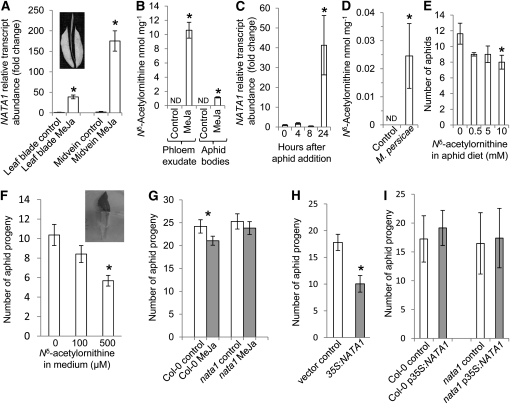Figure 5.
NATA1 Expression and Nδ-Acetylornithine Affect Arabidopsis–M. persicae Interactions.
(A) Expression of NATA1 in dissected leaf blades and midveins (inset), with and without 24 h MeJA elicitation. Mean ± se of n = 4 or 5.
(B) Nδ-acetylornithine in petiole exudates and aphids feeding for 1 d from plants treated 4 d earlier with MeJA. Mean ± se of n = 3.
(C) NATA1 expression with 25 aphids feeding on one leaf. Fold induction, with 0 h set to 1. Mean ± se of n = 3 or 4.
(D) Nδ-acetylornithine accumulation in Col-0 wild type after 4 d of M. persicae feeding. Mean ± se of n = 3.
(E) Aphid reproduction on artificial diet containing 0 (control), 0.5, 5, or 10 mM Nδ-acetylornithine. Mean ± se of n = 8.
(F) M. persicae reproduction on detached nata1-1 leaves with petioles in a tube containing Nδ-acetylornithine (see inset). Number of aphid progeny after 4 d. Mean ± se of n = 22.
(G) M. persicae reproduction wild type and nata1-1 after MeJA treatment. Mean ± se of n = 19.
(H) M. persicae reproduction on N. tabacum transiently expressing p35S:NATA1. Number of aphid progeny after 7 d. Mean ± se of n = 25.
(I) M. persicae reproduction on Arabidopsis wild-type Col-0 and nata1 mutant transformed with p35S:NATA1. Number of aphid progeny after 7 d. Mean ± se of n = 25 to 27. ND, not detected. *P < 0.05, t test relative to control samples.

